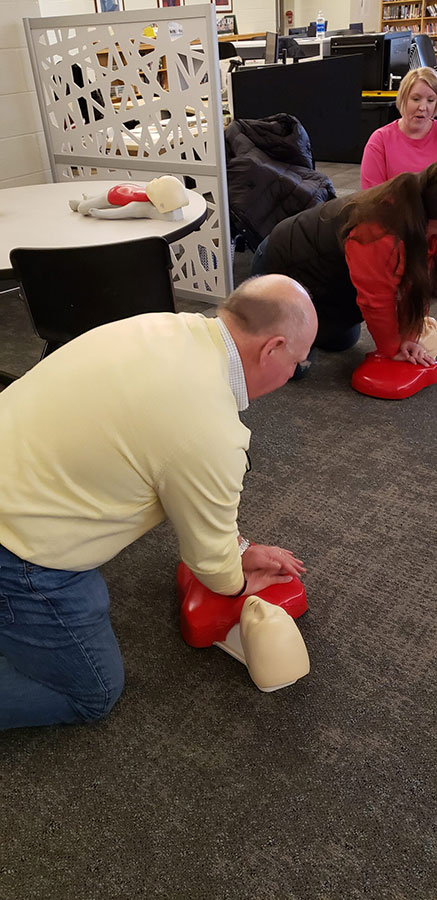
This January, the NFL’s Buffalo Bills’ safety, Damar Hamlin, suffered a heart attack on the field and was saved by quick-thinking CPR on-site while the nation watched. After this incident, many began to wonder whether they would be able to help if put in the same situation.
And, if you’re like me, you began to think, “I would guess a lot has changed since I was certified in high school, even if that was just (cough cough) a few years ago. How likely is this to happen to me?”
So, I registered for a recertification course with a group of friends. This is where I met Russ Girbach. He is currently a Firefighter/EMT-Basic with the Pittsfield Township Fire Department. He is an EMS instructor and also trains several local organizations like daycares, dentist offices, construction companies, lawn care companies, optometrist offices, pharmacies, schools, and fire departments.
During the class, Russ stated that each minute someone’s heart isn’t beating makes them 10% less likely to survive. Therefore, 10 minutes in cardiac arrest, means there is almost no chance of survival. So, having someone at the scene who knows CPR might save that life in keeping blood flow until professionals arrive and can use more advanced means of helping the patient.
 The American Heart Association recommends everyone have a, “Cardiac Emergency Response Plan” which is a written document that establishes the specific steps to reduce death from cardiac arrest in any setting – be it a school, community organization, workplace, or sports facility.” Their website provides checklists and recommended procedures.
The American Heart Association recommends everyone have a, “Cardiac Emergency Response Plan” which is a written document that establishes the specific steps to reduce death from cardiac arrest in any setting – be it a school, community organization, workplace, or sports facility.” Their website provides checklists and recommended procedures.
Who should get certified? Girbach stated, “I believe everyone, who is able, should get trained in CPR. People should get trained so they can recognize an emergency quickly and provide much needed care to these patients before first responders arrive. Providing early high quality CPR may be the difference in the patient surviving or not.”
“CPR is basically pushing on the chest to artificially pump the heart. During the certification class, students will learn proper hand placement and depth in practical sessions,” said Girbach.
You’ll also learn about defibrillators. Girbach noted, “Defibrillators are machines that look for two abnormal heart rhythms, if it finds one it delivers a shock. (Even the public as) lay rescuers are able to use them. The defibrillators, or AED as they are commonly referred to, are in public spaces where the general public can use them. These locations include malls, airports, libraries, schools, and sporting complexes just to name a few.”
You’ve probably walked by the machines without noticing they were there or what to do with them. Feeling comfortable with these machines and how they work, can be life saving in a moment of need. And still, many people might be leery of learning or administering CPR.
According to Girbach, “Some of the misconceptions people have (about giving CPR) are that it is hard, it will hurt the patient, and they will be held liable if they do it wrong or the patient does not survive. However,
- CPR is very easy, lay rescuer CPR is hands only now, meaning the rescuer does not need to provide rescue breaths. The American Heart Association has done a really good job at simplifying CPR so that those on scene feel more comfortable helping those in need (no longer requiring mouth to mouth contact) and only have a few things to remember. A few years ago, The AHA updated the technique to remove the breathing portion, which they feel encourages more people to feel comfortable administering CPR.
- If the patient is unconscious without a heartbeat, they will not feel anything you are doing. Furthermore, if it is not provided they will most definitely not survive (so no need to worry you’ll “hurt” them).
- Lastly, there is no liability as long as the rescuer is working within their scope of practice. Providing CPR, the rescuer is covered under the Good Samaritan Law.”
Another concern many have is the procedure for a child versus an adult.
“Adult (8-above) and Child (1-8) is virtually the same CPR, although for some smaller children, we may be able to just one hand to compress the chest. The rate (100-120 per minute) and depth (at least 2″) is virtually the same between these two age group,” Girbach said.
However, with an infant we use just two fingers or two thumbs to compress the chest, the rate is the same but depth is only 1.5 inches.”
Since Damar Hamlin’s incident on field, The American Heart Association partnered with him to encourage more people to learn CPR, creating a video to show the basics of CPR in just 60-seconds, found here.
There are many different reasons for learning CPR, but as with any emergency, practice and knowledge help you to prepare. The more people that know CPR and how to assist those in need, the more lives that can be saved.
Visit The American Heart Association’s website for more information, support, and classes.
Or, set up a certification class (mannequins are included) with Russ Girbach for your family, friends, school, or business.
Contact him by email, rgirbach@gmail.com, or phone (734)231-5408. Classes can be up to 20 people and are done on-site at your home or business.




